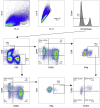Conserved T-cell epitopes of respiratory syncytial virus (RSV) delivered by recombinant live attenuated influenza vaccine viruses efficiently induce RSV-specific lung-localized memory T cells and augment influenza-specific resident memory T-cell responses
- PMID: 32585323
- PMCID: PMC7313889
- DOI: 10.1016/j.antiviral.2020.104864
Conserved T-cell epitopes of respiratory syncytial virus (RSV) delivered by recombinant live attenuated influenza vaccine viruses efficiently induce RSV-specific lung-localized memory T cells and augment influenza-specific resident memory T-cell responses
Abstract
Respiratory syncytial virus (RSV) can cause recurrent infection in people because it does not stimulate a long-lived immunological memory. There is an urgent need to develop a safe and efficacious vaccine against RSV that would induce immunological memory without causing immunopathology following natural RSV infection. We have previously generated two recombinant live attenuated influenza vaccine (LAIV) viruses that encode immunodominant T-cell epitopes of RSV M2 protein in the neuraminidase or NS1 genes. These chimeric vaccines afforded protection against influenza and RSV infection in mice, without causing pulmonary eosinophilia or inflammatory RSV disease. The current study assessed the formation of influenza-specific and RSV-specific CD4 and CD8 T-cell responses in the lungs of mice, with special attention to the lung tissue-resident memory T cell subsets (TRM). The RSV epitopes did not affect influenza-specific CD4 effector memory T cell (Tem) levels in the lungs. The majority of these cells formed by LAIV or LAIV-RSV viruses had CD69+CD103- phenotype. Both LAIV+NA/RSV and LAIV+NS/RSV recombinant viruses induced significant levels of RSV M282 epitope-specific lung-localized CD8 Tem cells expressing both CD69 and CD103 TRM markers. Surprisingly, the CD69+CD103+ influenza-specific CD8 Tem responses were augmented by the addition of RSV epitopes, possibly as a result of the local microenvironment formed by the RSV-specific memory T cells differentiating to TRM in the lungs of mice immunized with LAIV-RSV chimeric viruses. This study provides evidence that LAIV vector-based vaccination can induce robust lung-localized T-cell immunity to the inserted T-cell epitope of a foreign pathogen, without altering the immunogenicity of the viral vector itself.
Keywords: Live attenuated influenza vaccine; Respiratory syncytial virus; T cell immunity; Tissue-resident memory T cells; Viral vector.
Copyright © 2020 Elsevier B.V. All rights reserved.
Conflict of interest statement
All authors have no conflicts to disclose.
Figures









Similar articles
-
Recombinant live attenuated influenza vaccine viruses carrying CD8 T-cell epitopes of respiratory syncytial virus protect mice against both pathogens without inflammatory disease.Antiviral Res. 2019 Aug;168:9-17. doi: 10.1016/j.antiviral.2019.05.001. Epub 2019 May 7. Antiviral Res. 2019. PMID: 31075351 Free PMC article.
-
Cold-adapted influenza vaccine carrying three repeats of a respiratory syncytial virus (RSV) fusion glycoprotein epitope site protects BALB/c mice and cotton rats against RSV infection.Antiviral Res. 2024 Sep;229:105960. doi: 10.1016/j.antiviral.2024.105960. Epub 2024 Jul 8. Antiviral Res. 2024. PMID: 38986872
-
Tissue-Resident Memory T Cells in the Lungs Protect against Acute Respiratory Syncytial Virus Infection.Immunohorizons. 2021 Feb 3;5(2):59-69. doi: 10.4049/immunohorizons.2000067. Immunohorizons. 2021. PMID: 33536235 Free PMC article.
-
Novel Approaches for The Development of Live Attenuated Influenza Vaccines.Viruses. 2019 Feb 22;11(2):190. doi: 10.3390/v11020190. Viruses. 2019. PMID: 30813325 Free PMC article. Review.
-
Prospects for defined epitope vaccines for respiratory syncytial virus.Future Microbiol. 2010 Apr;5(4):585-602. doi: 10.2217/fmb.10.22. Future Microbiol. 2010. PMID: 20353300 Review.
Cited by
-
An intranasal influenza virus vector vaccine protects against Helicobacter pylori in mice.J Virol. 2024 Mar 19;98(3):e0192323. doi: 10.1128/jvi.01923-23. Epub 2024 Feb 15. J Virol. 2024. PMID: 38358289 Free PMC article.
-
The Roles of Tissue-Resident Memory T Cells in Lung Diseases.Front Immunol. 2021 Oct 11;12:710375. doi: 10.3389/fimmu.2021.710375. eCollection 2021. Front Immunol. 2021. PMID: 34707601 Free PMC article. Review.
-
Early RSV infection aggravates asthma-related Th2 responses by increasing the number of CD4 + TRM cells through upregulation of PLZF.Acta Biochim Biophys Sin (Shanghai). 2024 Dec 5;57(6):941-954. doi: 10.3724/abbs.2024220. Acta Biochim Biophys Sin (Shanghai). 2024. PMID: 39632661 Free PMC article.
-
Progress in combination vaccines and the co-administration of influenza virus and SARS-CoV-2 vaccines.Front Immunol. 2025 Jun 25;16:1578733. doi: 10.3389/fimmu.2025.1578733. eCollection 2025. Front Immunol. 2025. PMID: 40636108 Free PMC article. Review.
-
Expression of the SARS-CoV-2 receptor-binding domain by live attenuated influenza vaccine virus as a strategy for designing a bivalent vaccine against COVID-19 and influenza.Virol J. 2024 Apr 9;21(1):82. doi: 10.1186/s12985-024-02350-w. Virol J. 2024. PMID: 38589848 Free PMC article.
References
-
- Cepek K.L., Shaw S.K., Parker C.M., Russell G.J., Morrow J.S., Rimm D.L., Brenner M.B. Adhesion between epithelial cells and T lymphocytes mediated by E-cadherin and the alpha E beta 7 integrin. Nature. 1994;372:190–193. - PubMed
Publication types
MeSH terms
Substances
LinkOut - more resources
Full Text Sources
Medical
Research Materials
Miscellaneous

